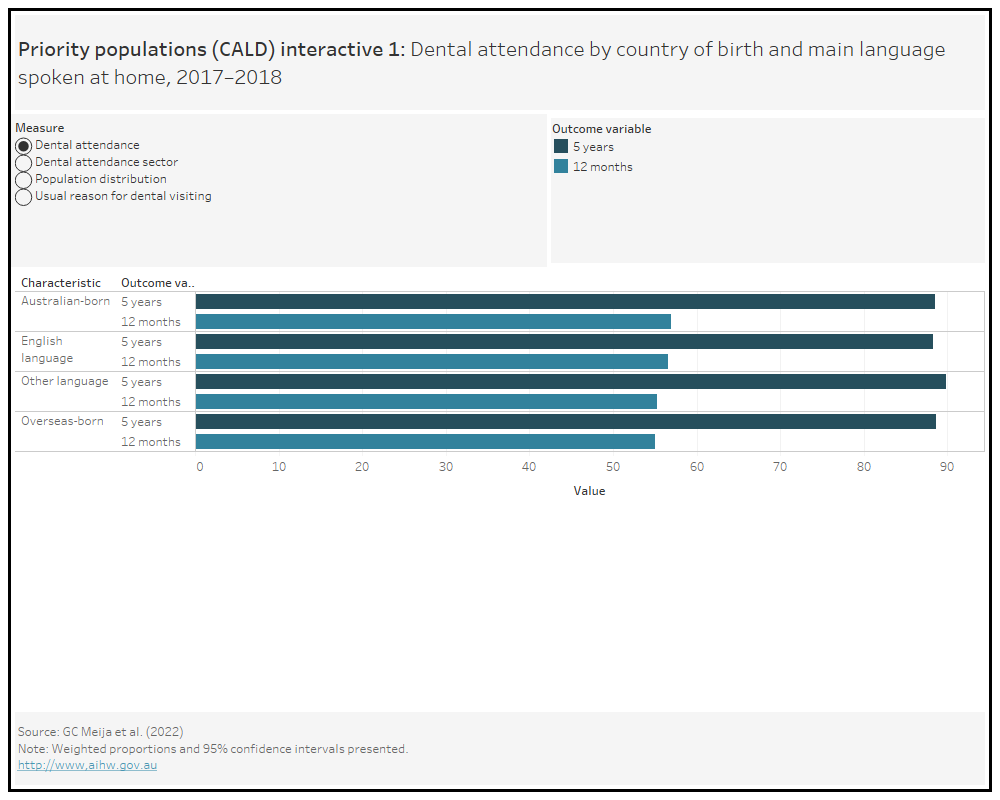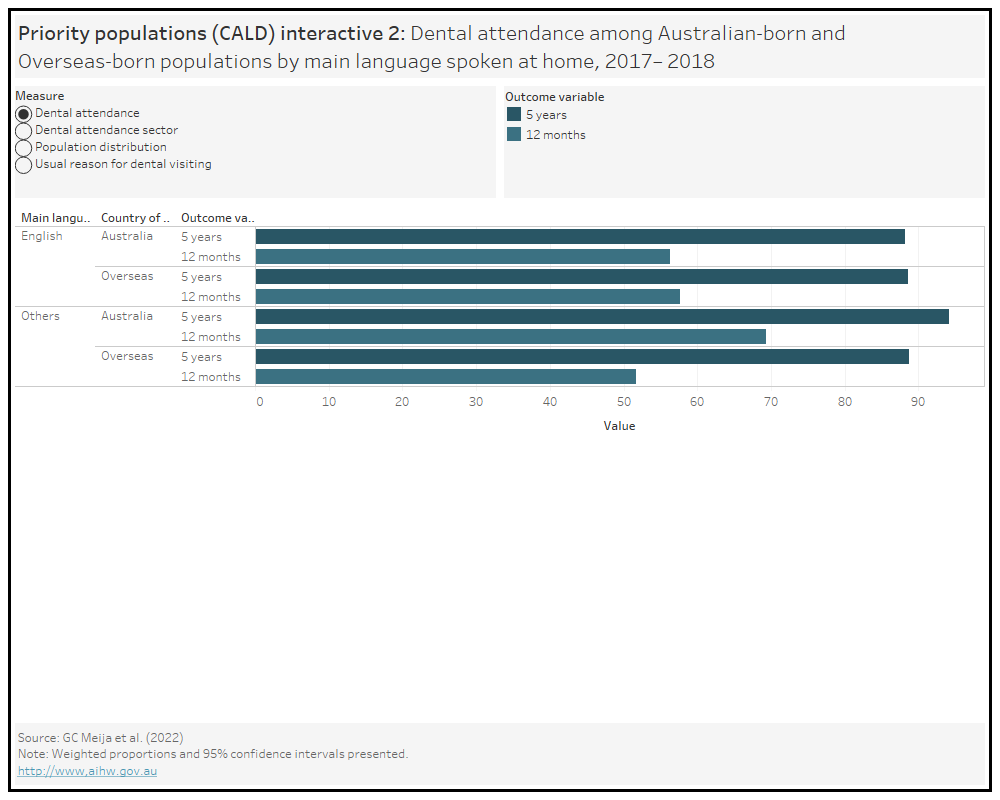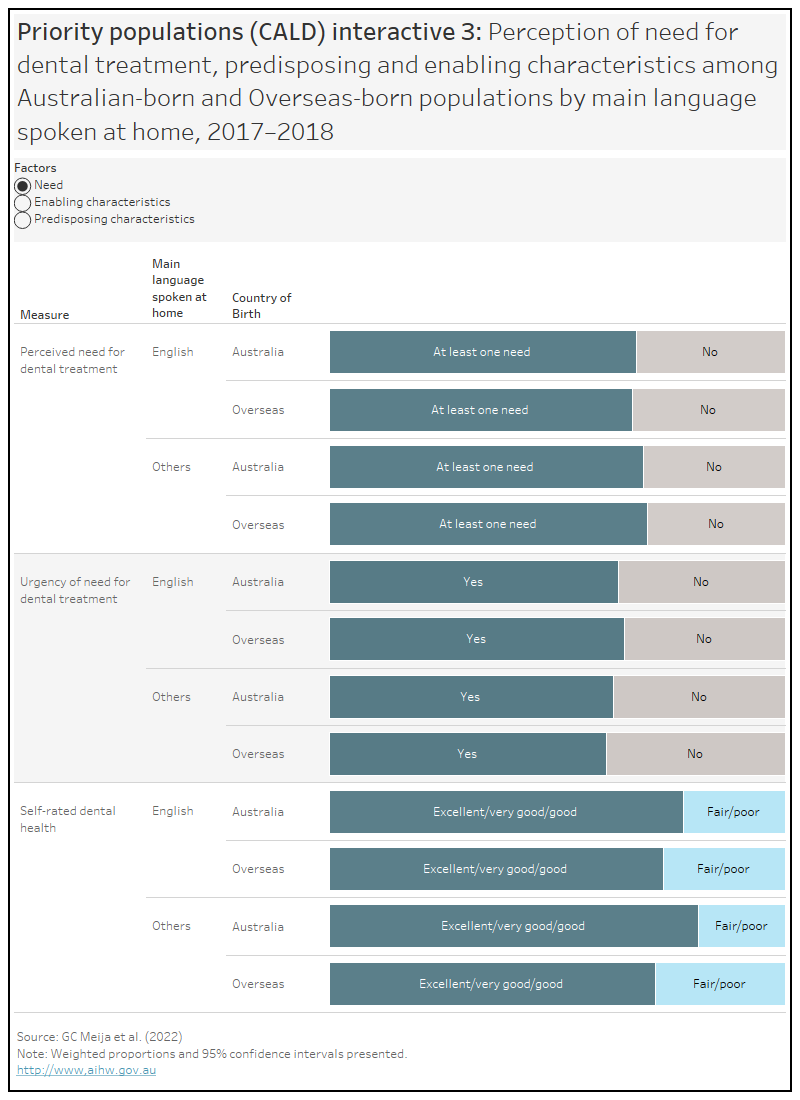People who are socially disadvantaged or on low incomes
This group has historically been identified as those on a low income and/or receiving some form of government income assistance, but now extends to include people experiencing other forms of disadvantage including refugees, homeless people, some people from culturally and linguistically diverse backgrounds, and people in institutions or correctional facilities (COAG 2015). Poorer oral health results from infrequent dental care. Barriers include cost, appropriateness of service delivery and lower levels of health literacy, including oral health (COAG 2015).
From the scientific literature
Immigrants experience oral health care inequity: findings from Australia’s National Study of Adult Oral Health (Jamieson et al, 2022)
The data used was collected from 15,727 participants using the Australia’s national Study of Oral Health (NSAOH) 2017-2018. The study aimed to assess the equity in access to services and patterns of use of oral health services among the Australian-born and overseas-born populations. The study also looked at whether there were any additional differences based on the main language spoken at home.
In 2017–18, people who spoke a language other than English were more likely to go to a public dental service (23%) than those who spoke English (17%).
In 2017–18:
- A similar proportion of those people who mainly speak English at home visited a dental practitioner in the last 12 months as those who mainly spoke another language, 57% and 55% respectively.
- Around 1 in 10 (11%) people either born in Australia or born overseas had not visited a dental practitioner in the last 5 years.
- Most people (63%) usually visited a dental practitioner for a check-up rather than for a problem irrespective of main language spoken at home.
Explore the data using the priority population interactive 1 below.
Priority populations (People who are socially disadvantaged or on low incomes) – Interactive 1
The figure shows dental attendance by country of birth and main language spoken at home. In 2017-2018, 57% of those people born in Australia and 55% of those people born overseas visited a dental practitioner in the last 12 months.

See Data tables: People who are socially disadvantaged or on low incomes for data tables.
In 2017–18, those born in Australia who mainly spoke a language other than English at home were most likely to have a dental visit in the last 12 months (69%)
In 2017–18:
- More people who were born in Australia who mainly spoke a language other than English at home had visited a dental practitioner in the last 12 months than those born in Australia who mainly spoke English at home, 69% and 56% respectively.
- 1 in 4 (24%) people born overseas who mainly spoke a language other than English at home visited a public dental service compared to 1 in 6 (16%) people born overseas who mainly spoke English at home.
- More people who were born in Australia who mainly spoke a language other than English at home usually visited a dental practitioner for a check-up (77%) than those born in Australia who mainly spoke English at home (63%).
Explore the data using the priority population interactive 2 below.
Priority populations (People who are socially disadvantaged or on low incomes) – Interactive 2
This figure shows dental attendance among Australian-born and Overseas-born populations by main language spoken at home. In 2017–18, around 7 in 10 (69%) of those people born in Australia who speak mainly speak a language other than English at home has visited a dental practitioner in the last 12 months.

See Data tables: People who are socially disadvantaged or on low incomes for data tables.
In 2017–18, people who were born overseas and mainly spoke a language other than English at home were most likely to have needed dental care but avoided due to costs (42%)
In 2017–18:
- A greater proportion of those people born overseas who mainly spoke a language other than English at home avoided or delayed visiting a dental practitioner due to cost (49%) than those born overseas who mainly spoke English at home (38%).
- Cost prevented recommended dental treatment for around 1 in 3 (32%) people born overseas who mainly spoke a language other than English at home compared to around 1 in 5 (21%) people born in Australian who mainly spoke English at home.
Explore the data using the priority population interactive 3 below.
Priority populations (People who are socially disadvantaged or on low incomes) – Interactive 3
This figure shows the perception of need for dental treatment, enabling and predisposing characteristics among Australian-born and Overseas-born populations by main language spoken at home. Around 7 in 10 (69%) of people born overseas who mainly speak a language other than English at home reported having at least one dental need.

See Data tables: People who are socially disadvantaged or on low incomes for data tables.
The health of Australia’s prisoners 2018
People in contact with the criminal justice system often come from socioeconomically disadvantaged backgrounds (AIHW 2019).
People in prison have higher rates of tobacco smoking and high-risk alcohol consumption than the general population (AIHW 2015) which are behaviours that are known to increase the risk of oral disease (AIHW 2020).
The health of Australia's prisoners 2018 presents the results of the 5th National Prisoner Health Data Collection (NPHDC) in Australia. The NPHDC is the main source of national data about the health of people in prison in Australia. Data for the NPHDC were collected in 2-week periods in all states and territories, except New South Wales.
During the 2-week NPHDC data collection period, one-quarter (25%) of prison discharges said they had been diagnosed with a dental condition at some stage in their lives.
Similar to general practice in the community, prison clinics provide primary health care to people in custody. A visit to the prison clinic may be initiated by the patient (person in custody) or by clinic staff. During the 2-week NPHDC data collection period just over one-quarter (28%) of clinic visits were initiated by the patient. Patients were more likely to initiate clinic visits for dental conditions (70%) whilst clinicians were more likely to initiate clinic visits for pathology (83%).
AIHW 2015. The health of Australia’s prisoners 2015. Cat. no. PHE 207. Canberra: AIHW.
Australian Institute of Health and Welfare 2019. The health of Australia’s prisoners 2018. Cat. no. PHE 246. Canberra: AIHW. doi:10.25816/5ec5c381ed17a
Australian Institute of Health and Welfare 2020. National Oral Health Plan 2015–2024: performance monitoring report. Cat. no. DEN 232. Canberra: AIHW. Viewed 16 February 2021.
Mejia, G. C., Ju, X., Kumar, S., Soares, G. H., Balasubramanian, M., Sohn, W., & Jamieson, L. (2022). Immigrants experience oral health care inequity: findings from Australia's National Study of Adult Oral Health. Australian Dental Journal.


